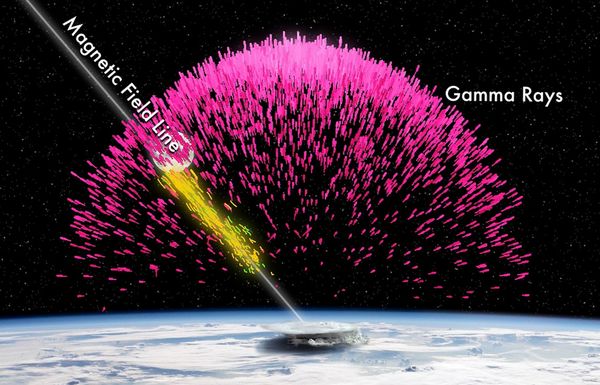
Most so-called normal matter is made of subatomic particles such as electrons and protons. Antimatter, on the other hand, is made of particles that have the same masses and spins as their counterparts but with opposite charges and magnetic properties.
Recently, radiation detectors on NASA's Fermi Gamma-ray Space Telescope lighted up for about 30 milliseconds with the distinctive signature of positrons, the antimatter counterparts of electrons.
Scientists were able to trace the concentrated burst of radiation to a lightning flash over Namibia, at least 3,000 miles (5,000 kilometers) away from the Earth-orbiting telescope, which was passing above Egypt at the time.
"This is a fundamental new discovery about how our planet works," said Steven Cummer, a lightning researcher from Duke University who was not part of the study team.
"The idea that any planet has thunderstorms that can create antimatter and launch it into space is something out of science fiction. The fact that our own planet is doing it is truly amazing."
Intense Antimatter Beam a Shocker
Scientists already knew that thunderstorms can emit gamma rays - the most energetic form of light - and that gamma rays in turn can create positrons through a process called pair formation.
When a gamma ray with the right amount of energy interacts with an air atom, energy from the gamma ray is converted into matter, one electron and one positron, lightning expert Joseph Dwyer said yesterday during a meeting of the American Astronomical Society in Seattle, Washington.
Scientists wouldn't have been surprised to see a few positrons accompanying any intense gamma ray burst, added Dwyer, of the Florida Institute of Technology in Melbourne.
But the lightning flash detected by Fermi appeared to have produced about 100 trillion positrons: "That's a lot," he said.
What seems to have happened is that positrons created by the lightning were herded into a tight beam by Earth's magnetic field, said study leader Michael Briggs of the University of Alabama, Huntsville.
The beam funneled positrons from the Namibian storm to the Fermi spacecraft.
A few milliseconds after hitting the spacecraft, the beam struck a more northerly section of Earth's magnetic field, Briggs added. This caused some of the positrons to bounce back the way they had come, hitting the spacecraft with a second beam, like an echo.
Antimatter a Clue to Lightning
Earth is constantly being bombarded by radiation from the sun, as well as cosmic rays from distant but violent events, such as powerful supernovae.
Considering the amount of positrons in the beam Fermi detected, the thunderstorm was briefly creating more radiation - in the form of positrons and gamma rays - than what hits Earth's atmosphere from all other cosmic sources combined, Dwyer noted.
The researcher has previously said, however, that the danger of thunderstorm radiation to airline travelers is extremely low.
Duke's Cummer added that nobody knows why some thunderstorms produce gamma rays while most do not.
"We really don't understand a lot of the details about how lighting works," he said. But discovering the creation of positrons "gives us a very, very important clue as to what's happening."
A paper about the discovery of antimatter in thunderstorms has been accepted for publication in the journal Geophysical Research Letters.



Reader Comments
to our Newsletter